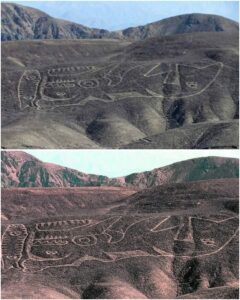Introduction to the Orca Geoglyph
Hidden on an arid hillside in the remote Palpa region of southern Peru, the 2,000-year-old orca geoglyph is one of the oldest and most historically valuable geoglyphs in the country. Measuring approximately 40 meters in length, this remarkable orca figure is intricately carved into the desert sand, symbolizing the creativity and advanced artistic skills of ancient civilizations in the area.
This geoglyph is not only an artistic masterpiece but also a vivid testament to the symbolic and cultural significance of geoglyphs in ancient Andean societies. These rock carvings were likely central to the spiritual life and social rituals of ancient people.
Artistic Analysis and Techniques of the Ancients
The creation of the orca geoglyph at such an impressive scale and with precise detailing reflects the sophisticated design techniques of ancient Peruvians. Geoglyphs were often made by removing the dark surface rocks to reveal lighter earth beneath, creating sharply defined figures visible from afar. Researchers believe the people of Palpa carefully selected specific sites and angles so that, when viewed from above, the geoglyphs appear especially vivid and striking.
The orca may have symbolized power and dominance in nature within the Andean spiritual beliefs, associated with water and abundance. The depiction of this marine animal underscores the deep connection between ancient Andean people and the natural world surrounding them.

The Role of Geoglyphs in Andean Culture
The orca geoglyph and others in the Palpa region played important roles beyond mere artistry, potentially serving religious and social functions. Scholars suggest that these geoglyphs may have been sites for religious ceremonies, expressing reverence for deities or ancestral spirits in hopes of protection and favorable harvests. Additionally, these large-scale carvings might have acted as markers or guides across the vast desert landscape, assisting ancient travelers with navigation.
These geoglyphs may also serve as symbols of the symbiotic relationship between humans and nature, reminding us of the powerful natural forces with which they coexisted. This highlights the close connection between spiritual life and nature in Andean societies.
Preservation and Modern Discoveries
Today, the preservation of the orca geoglyph is a critical task not only for researchers but also for local authorities and international organizations. Protecting and maintaining these ancient artworks allows future generations to understand the creativity, knowledge, and culture of their ancestors. Thanks to modern technology like laser scanning and satellite imaging, scientists can study the geoglyphs in depth without disturbing the site.
Modern technology not only enables us to better understand the geoglyphs’ construction, structure, and meaning but has also helped uncover previously unknown figures, opening new doors to explore the history and culture of the Andes.

Conclusion: A Timeless Cultural Legacy
The orca geoglyph in Palpa is a vivid testament to the ingenuity and creativity of ancient Andean civilizations and reflects a sacred connection between humans and nature. Through preserving and studying these geoglyphs, we gain insights not only into the past but also into the deep cultural heritage and identity of these ancient societies.
With technological advancements, we hope that more mysteries and valuable information about these geoglyphs will continue to be uncovered, enriching humanity’s understanding of the history, culture, and beliefs of those who inhabited this land thousands of years ago.
